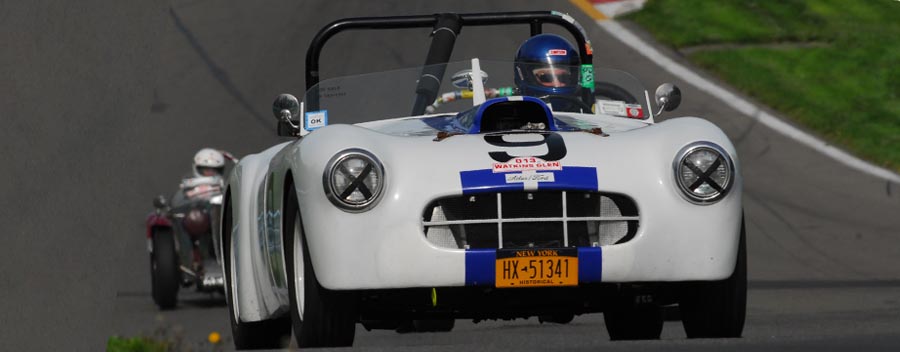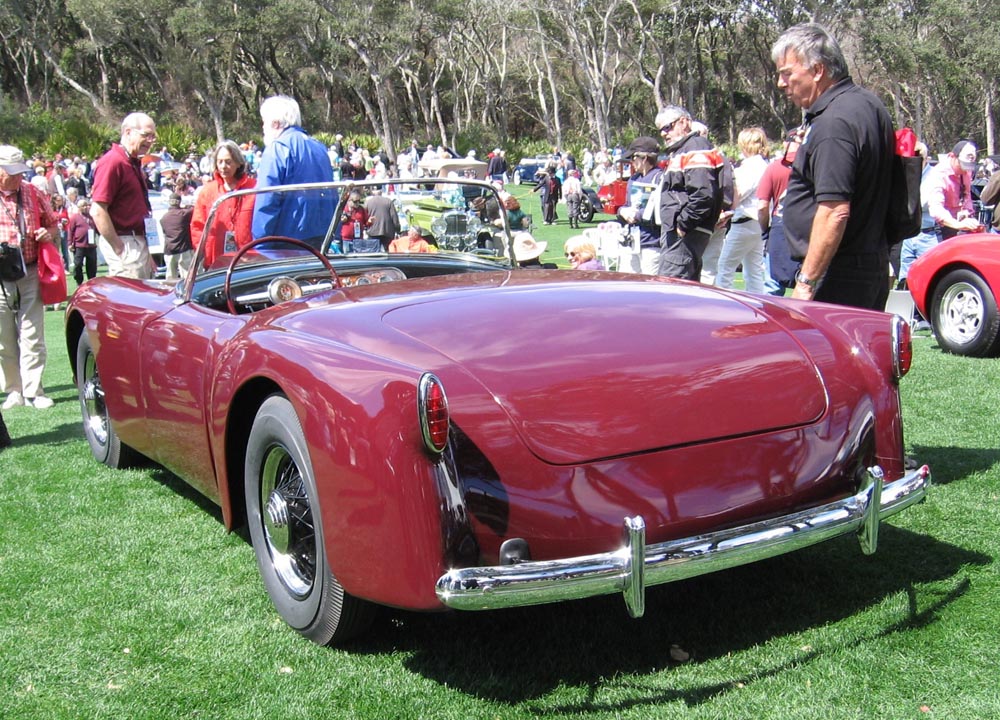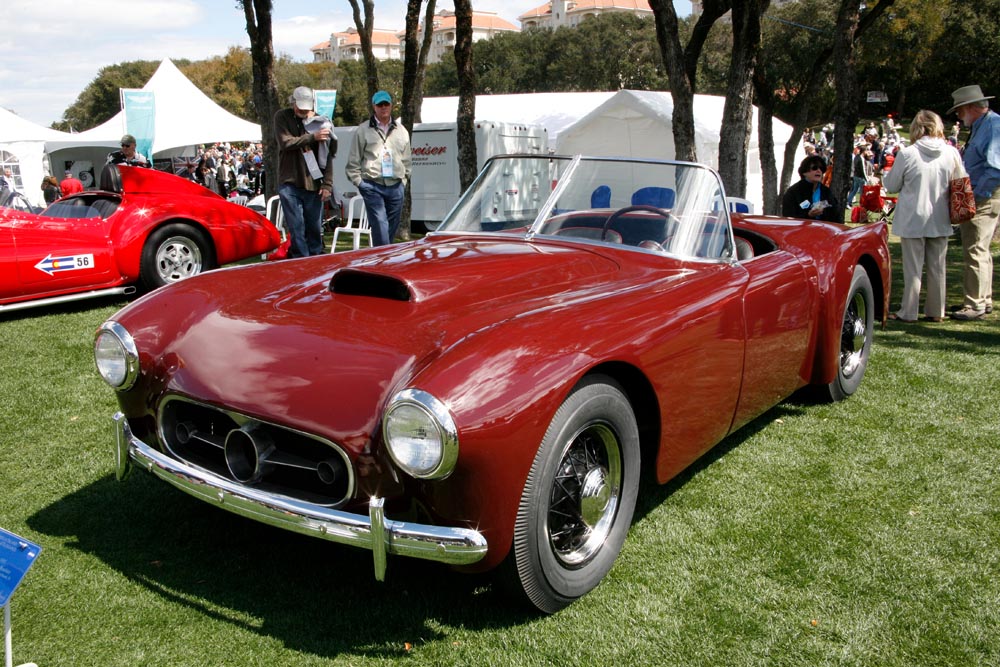
Hi Gang…
The “hunt” is on!
Well….it’s been “on” here at Forgotten Fiberglass for about a decade, and with your help we’ve solved many a mystery – but many remain to be solved. Like today’s story about Bob Duell’s sports/race car – a car that should look quite familiar to many of you. It’s another version of what Rick D’Louhy and I call the “Californian.”
 So far we’ve found two nice examples like this built in a near identical manner – down to the layout of the trunk and mounting to the frame. This strongly suggests that these cars were built by someone or a group of folks intent on building multiple versions – and perhaps for sale. Or they could have been bought and built by the same customer. In any event, someone produced more than one of these, and so far we’ve found two cars and an unused body.
So far we’ve found two nice examples like this built in a near identical manner – down to the layout of the trunk and mounting to the frame. This strongly suggests that these cars were built by someone or a group of folks intent on building multiple versions – and perhaps for sale. Or they could have been bought and built by the same customer. In any event, someone produced more than one of these, and so far we’ve found two cars and an unused body.
Very few of the stories we research end with just one car. That may have been how the story and “dream” started, but by the time the designer/builder/proprietor was done with their first intended car/body, the excitement to produce another body and build another car was often just too strong – especially if a mold was available.
All we’ve been able to find so far when tracing the history of these cars is that each car found and the fiberglass body located all track back to Los Angeles. That’s where the trail grows cold.
Several years ago Jim Giles who previously owned one of these cars researched the history and identified that the car may well be the large 100″ wheelbase roadster version of an Allied / Atlas – the cars built by Bill Burke, Mickey Thompson, and Roy Kinch. Enthusiastically, we shared the photos of these cars with Bill Burke in 2008/2009, but he quickly discounted this possibility. Close but no cigar.
Jim Giles, though, is still hot on the trail fiber-gang
Today’s story comes in from good friend Bob Deull who owns the “Atlas” featured in this article – his version of what we call the “Californian.” The name “Atlas” derives from the point in research that Jim Giles was at when we were trying to identify the cars many years ago. Since we still don’t know the name or heritage of the car, the name “Atlas” still works for us (as long as we separate it from the heritage of the true Atlas company mentioned above).
A few years ago, an article was written about Bob’s Atlas in a French-Canadian newspaper – “La Presse Montreal“. Bob had the article translated and sent it in. Let’s have a look at what they had to say about Bob’s wonderful race car – The Atlas Special.
55 Years Later, This Atlas-Ford Is Still Running
Éric Descarries – Special Contribution // Translated by Carl Cornell
WATKINS GLEN, New York – When Bob Deull, of Sanborn, New York, learned that there was a 1953 Atlas-Ford for sale in Arizona, he did not hesitate. He had a strong recollection of a similar car that his cousin drove during the 1950s. However, only about fifty Atlases were ever produced. Mr. Deull, an insurance adjuster in the Buffalo region, was very aware of the history of this automobile.
A Borrowed Design
The story of the auto manufacturer Allied-Atlas is a bit obscure. According to the legend, as Mr. Deull tells it at the US Zippo Grand Prix at the Watkins Glen circuit, the make was first produced in Los Angeles in 1952. The drivers Mickey Thompson and Bill Burke (holders of speed records in Bonneville) borrowed the Cisitalia 202 Coupe that Robert Peters, the then-editor of the magazines Hot Rod and Motor Trend, had just ordered in Italy.
From the Cisitalia they made, without Peters’ knowledge, plaster molds in the workshop of the coachbuilder George Barris. They then asked a certain Roy Kinch, specialist in fiberglass, which was then a new material, to reproduce it on a small car chassis, like the MGs and the Triumphs of the time. Later, they enlarged the bodywork so that it could be fixed on North American chassis.
Bob Beull’s (sic) Atlas-Ford is one of the automobiles of this latter generation. It sits on a modified Ford 1940 chassis, which conserves its transverse leaf spring suspension. Under the hood is a venerable 1949 Ford V8 Flathead motor, modified with an Edelbrock intake manifold with three single-barrel carburetors and Fenton cylinder heads, which gives it about 210 horsepower.
The previous owner had had the Atlas restored after discovering it at a flea market in San Diego; it was missing mechanical pieces such as the gearbox and the back axle, later replaced by a more modern T-10 gearbox and an axle from a 1960s Mercury Comet. Mr. Beull (sic) claims that his Atlas is only one of two vehicles of its type still running. At Watkins Glen, the automobile drove on more modern (and certainly safer) BFGoodrich Touring T/A tires.
When he started the motor, the few onlookers present were quickly reminded of the characteristic sound of the Flathead exhaust pipe. It is worth mentioning that these spectators were all in their fifties…or older.
Racing Experience
Although Mr. Deull used his Atlas for the first time at Watkins Glen, it was not the first time the automobile has been on track. Indeed, this roadster had participated in twenty some events in racing series for vintage cars of the American West. It still sports an Oregon license plate, having been driven by Portland’s Paul Ingram. Bob Deull was thus proud to take his first laps with his Atlas.
It was not his final finishing place or the performance of the automobile that mattered most to the happy owner: it was finding the car that his cousin drove in 1955.
Photos captions: Left – the Atlas’ vertical taillights are those of a 1949 Ford. Right – Bob Deull is not afraid of entering his Atlas in contests.
Note From Geoff: You’ll notice that the story above references the story of the Atlas/Allied Company owned by Bill Burke, Mickey Thompson, and Roy Kinch. The story about Bob Deull’s sports car was printed in the Canadian newspaper before the full history was known about the car in today’s story and the “Californian.” Both remain mystery cars in search of their story as of the date of this posting, and are not related to Bill Burke’s company above – the Atlas/Allied Fiberglass Company (as far as we know at this date).
Summary:
So how many more “Californians” or “Atlas” sports cars might there be out there? What about more history on each of these cars? Are you interested in learning more about what else we have found that clues us “in” on the history?
Hope you enjoyed the story, and remember…for more information…
The adventure continues here at Forgotten Fiberglass.
Geoff















Hello Geoff
Thank you for your fantastic work about all the fiberglass cars! They are certainly a very interesting part of American automotive history.
I just recently purchased the car from Bob Deull,
after having seen pictures of Paul Ingram racing it 15 or so years ago years. I kept a picture in a “favorite cars” file. Then I saw the car advertised, reached out to Bob and purchased it.
The car will see quite a bit of use, as I am an avid driver and rally participant.
I also own a Devon special with a 356 Porsche engine, which is getting exercised regularly.
Just thought I would reach out to you to make the connection.
All the best,
Christian
Geoff:
Have been enjoying all the posts on Forgotten Fiberglass, keep up the documentation of all the cars!
I was pleased to see the information on the “Californian, Atlas, Allied, etc.” The car that Bob Deull has now was what I called an Atlas/Ford and never found who the original builder of the body was.
I purchased the car Bob Duell has in 1997 as a chassis and body only, and in pretty sad condition. Upon rebuilding the car I raced it at Seattle, Portland, Laguna Seca, and other venues on the West Coast. Lots of fun and always drew a crowd.
While I had the car I collected a file of information on fiberglass bodys but never did get a fix on who, why, or when it was built. Jim Giles had the only duplicate, and it is the car you have called the Californian.
Am on the chase for a Glaspar G2 and a Phoeniz but have not secured either of them yet.
Again, keep up the good work!
Respectfully, Paul Ingram
Hello Paul
My name is Christian Reichardt and I am the proud owner of the car you built!
I bought it from Buell a few months back and it now resides in Southern California.
I am fixing little things here and there, but overall the car is running well.
I would love the opportunity to chat with you about the car, my number is 310-600-8872. Please let me know if you would be up for it
A great story.
I have a suggestion for Mr. Deull. I would relocate the coil so that the coil wire doesn’t have to be 2′ – 3′ long to wrap around the engine in order to reach the coil.
When I was a kid in Waterloo, Iowa, there was a dentist, Dr. Yeager, that bought the standard gas station next to his office so his son Larry to work out of and pursue his automotive hobby
( It worked, Larry became the area tuning guru, had a chassis dyno and then later became associated with Sun Instruments.)
They had a home built sports car there, I think they put it together from a kit. It was a 1940’s Ford chassis and drive train. I think the frame was shortened. the body was fiberglass and very light. I think perhaps the builder never got the interior sheet metal fully done. Perhaps rear wheel houses only. Honestly, I cannot remember but it seems like it was a roadster, black in color. I think perhaps it had been started quite a bite earlier, made drivable and then abandoned.
this would have been 1962-1963 era. I was only 14 and there were NO high end cars except a few Jag XK’s and Porsches, but mostly Corvettes.
I had read a few milestone books like Costin/ Phipps and had seen pictures of Lotus chassis.
To look at this thing with its early Ford suspension made this 14 year old think two things:
QUICK AND SCAREY My friend had a Bug Eye Sprite and this Ford special might have had 3 times the power to weight. And that suspension was as different from the modern stuff as could be.
IT WOULD HAVE BEEN FUN, THOUGH!
I’m sure Dr. Yeager built it, not sure where he got the body from.I have no idea what happened to it
A few years later I was very seduced by the Fiberfab stuff, but never made the plunge.
Good job on this site, by the way.
Al Brase